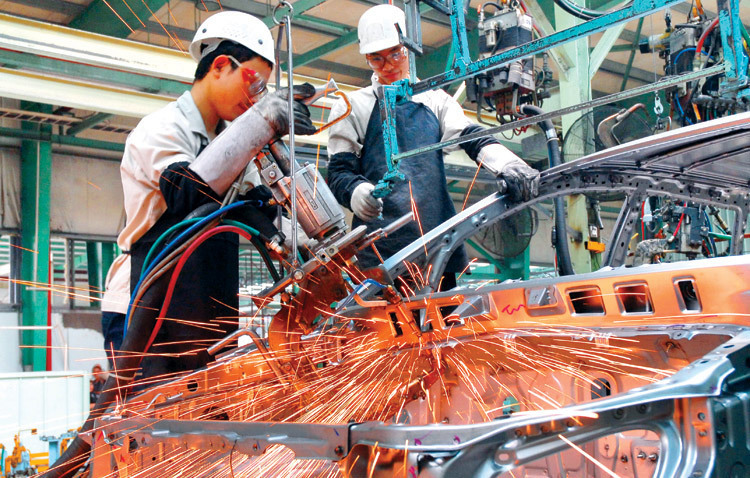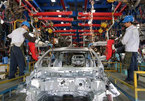ASEAN top 3 is the goal
Resolution 23-NQ/TW dated March 23, 2018 of the Party Politburo sets the goal that Vietnam would complete the task of industrialization and modernization, basically becoming a modern industrial country, and included in the ASEAN top 3.

To reach the goal, the resolution pointed out that priority should be given to some mechanical industries such as automobile, agricultural machines, construction equipment, industrial equipment, electrical equipment, and medical equipment.
It is necessary to give support to develop suppliers in priority industries, which is the core of the policy on supporting industry development.
As such, automobile and automobile supporting industries will be prioritized to develop from now to 2030.
Vietnam’s automobile industry is still very small. A report from the Ministry of Industry and Trade (MOIT) found that automobile output in 2019 totallef 281,606 products, much lower than the total capacity of 800,000 products. The figure was small compared with Thailand (2 million cars a year) and Indonesia (1.2 million).
Low output
Local supporting industries are also small with 276 car part manufacturers who provide products to 40 automobile assemblers. Meanwhile, Thailand has more than 2,000 and Indonesia 800.
Experts pointed out that in order to develop the automobile industry, it is necessary to develop supporting industries. But the supporting industries are weak in competitiveness.
A representative of Toyota Vietnam said at a seminar on the role of tax and customs policies in the automobile industry on November 3 that the manufacturer can buy a fuel tank cap at $1.5 per product, while a Vietnamese vendor offered the product at $3.8.
After helping the vendor cut down unnecessary costs and sending staff to the vendor’s production facility to support the production process, the price was lowered to $2.5. However, the price is still $1 higher than the products from Thailand.
Pham Van Tuan, general director of Eco Vietnam, also said that enterprises have import materials at high prices because of small orders. The expenses on materials account for 60-70 percent of production costs.
The logistics cost in Vietnam is also high, accounting for 8-10 percent, while bank loan interest and other expense items account for 5-7 percent. Therefore, it is difficult to compete with imported car parts from Thailand which enjoy a preferential tariff of zero percent.
| Resolution 23-NQ/TW dated March 23, 2018 of the Party Politburo sets the goal that Vietnam would complete the task of industrialization and modernization, basically becoming a modern industrial country, and included in the ASEAN top 3. |
Sharing the same view, a representative from Hanoi Plastics said the production of car parts does not bring high profits. In order to make higher profit, enterprises should produce products in large quantities.
Contradictory policies
To develop supporting industries, the automobile industry needs to have large output. To encourage demand in the context of the people’s low incomes, it is necessary to slash taxes and fees, which helps reduce car prices.
Le Duong Quang, chair of the Vietnam Supporting Industries Association, said that tax policy is an important tool to develop the auto industry and supporting industries. Imposing high luxury taxes on cars will not encourage the consumption of cars.
“I was astonished when hearing that there are 500,000 cars of different kinds in Vientiane. Hanoi has 600,000 cars. Hanoi’s population and income per capita is higher than Vientiane's,” he said, adding that the tax policy in Laos encourages the consumption of cars.
Quang saud that the government and appropriate agencies are still unsure about the policies for the auto industry. Vietnam wants to develop the industry, but its tax policies clearly discourage consumption.
According to the General Department of Customs (GDC), under the zero percent preferential import tariff program in accordance with Decree 125, 13 enterprises have met the requirements to receive the preferences of the program and have received tax refunds of VND9.5 trillion since late 2017.
According to the Ministry of Finance, enterprises receive tax refunds, but make great contributions to the state budget collections. In 2018, for example, four manufacturers, Toyota Vietnam, TC Motor, Truong Hai and Ford, paid VND7.3 trillion more in taxes than in 2017. Meanwhile, the tax amount paid in 2019 was VND4 trillion higher than 2018.
Analysts said the zero percent preferential tariff on car part imports helps reduce expenses on car parts bought from non-ASEAN countries and the production cost of some domestically assembled models by 3-5 percent, thus allowing lower selling prices.
If the state continues reducing taxes and fees, this would help increase car output and help develop the automobile and supporting industries, which would lead to higher state budget collections.
Tran Thuy

The last chance for Vietnam’s automobile industry
The Ministry of Planning and Investment (MPI) is compiling a plan to develop the automobile industry in the post-Covid-19 period with many new solutions.

Gov’t support aids automobile industry
The domestic automobile industry was forecast to thrive, given the Government’s supports in tax policies for imported automobile components coupled with the increasing income of citizens.